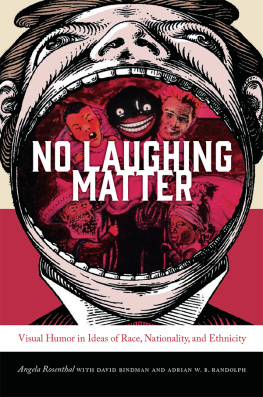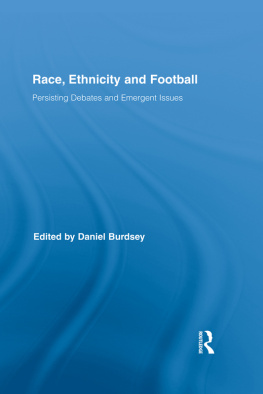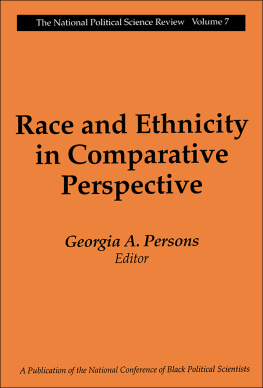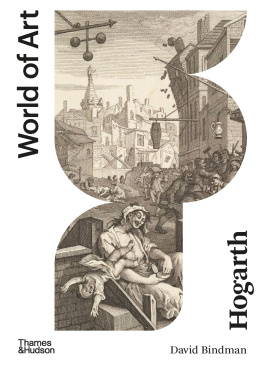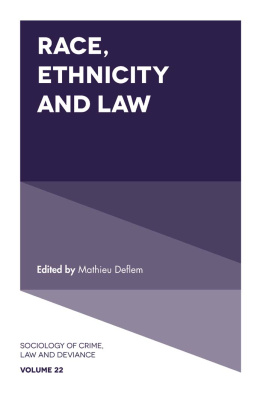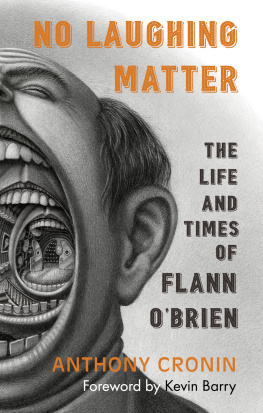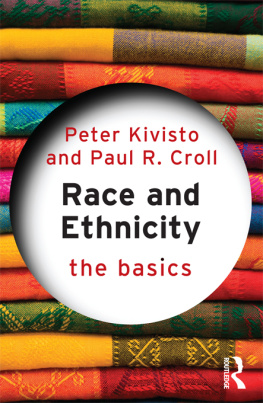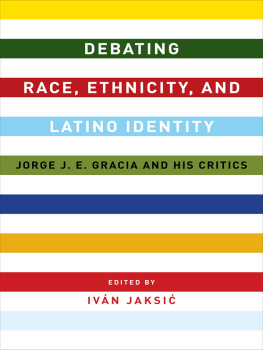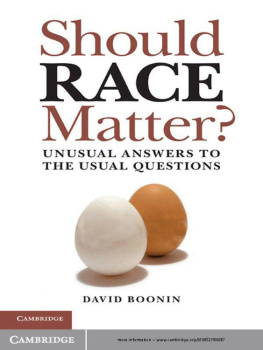Bindman David - No Laughing Matter: Visual Humor in Ideas of Race, Nationality, and Ethnicity
Here you can read online Bindman David - No Laughing Matter: Visual Humor in Ideas of Race, Nationality, and Ethnicity full text of the book (entire story) in english for free. Download pdf and epub, get meaning, cover and reviews about this ebook. City: Hanover;New Hampshire, year: 2016, publisher: Dartmouth College Press, genre: Art. Description of the work, (preface) as well as reviews are available. Best literature library LitArk.com created for fans of good reading and offers a wide selection of genres:
Romance novel
Science fiction
Adventure
Detective
Science
History
Home and family
Prose
Art
Politics
Computer
Non-fiction
Religion
Business
Children
Humor
Choose a favorite category and find really read worthwhile books. Enjoy immersion in the world of imagination, feel the emotions of the characters or learn something new for yourself, make an fascinating discovery.
- Book:No Laughing Matter: Visual Humor in Ideas of Race, Nationality, and Ethnicity
- Author:
- Publisher:Dartmouth College Press
- Genre:
- Year:2016
- City:Hanover;New Hampshire
- Rating:3 / 5
- Favourites:Add to favourites
- Your mark:
- 60
- 1
- 2
- 3
- 4
- 5
No Laughing Matter: Visual Humor in Ideas of Race, Nationality, and Ethnicity: summary, description and annotation
We offer to read an annotation, description, summary or preface (depends on what the author of the book "No Laughing Matter: Visual Humor in Ideas of Race, Nationality, and Ethnicity" wrote himself). If you haven't found the necessary information about the book — write in the comments, we will try to find it.
Bindman David: author's other books
Who wrote No Laughing Matter: Visual Humor in Ideas of Race, Nationality, and Ethnicity? Find out the surname, the name of the author of the book and a list of all author's works by series.
No Laughing Matter: Visual Humor in Ideas of Race, Nationality, and Ethnicity — read online for free the complete book (whole text) full work
Below is the text of the book, divided by pages. System saving the place of the last page read, allows you to conveniently read the book "No Laughing Matter: Visual Humor in Ideas of Race, Nationality, and Ethnicity" online for free, without having to search again every time where you left off. Put a bookmark, and you can go to the page where you finished reading at any time.
Font size:
Interval:
Bookmark:

ONE
Carnivalesque and Grotesque
What Bakhtins Laughter Tells Us about Art and Culture
KOBENA MERCER
Laughter matters for all sorts of reasons, and, by way of beginning, I will try to identify three of them. Because it gives us pleasure, laughing is something we enjoy for its own sake: it really serves no useful purpose, and yet it has the power to change our feelings in an instant. When we say that good humor lightens our mood or lifts our spirits, we acknowledge the way pleasure mitigates anxiety. In the face of tensions that inevitably arise when one self encounters another, we might observe that humor breaks the iceit lifts the tension in a way that loosens us from rigid bodily postures of fear or anxiety. This brings me to a second observation, which is that although we may laugh alone, laughing is an intrinsically sociable experience. Whatever its medium of expressionverbal, visual, literary, or theatricalthere is a communal aspect to laughter whereby the boundaries that separate one solitary individual from another are momentarily lifted as we become members of an audience, a crowd, an imagined community. As Henri Bergson suggested in 1899, laughter appears to stand in need of an echo... our laughter is always the laughter of a group. But if laughter is highly sociable, then this is also the very point at which humor and comedy reveal their antisocial side. Wherever in-jokes are performed at the expense of out-groups that find themselves on the receiving end of a punch line, laughter reveals its violently divisive potential. Laughter is thus essentially ambivalent as a phenomenon of social bonding that also brings to light the symbolic boundaries of group belonging.
Examining such artists as Betye Saar, Robert Colescott, and David Hammonswho each welcome laughter into the critical reception of contemporary works that address the legacy of blackface minstrelsy in American visual culturethe issue of ambivalence, and how to examine it, is one of my overarching themes of concern. Ordinarily we try to get at this ambivalence by asking whether an audience is being invited to laugh at or to laugh with a given comic situation. When we make this distinction we get a handle on the enunciative directionality of comic performance; but to the extent that we presuppose a grammar or syntax for laughterwith clear-cut distinctions among subject, object, and predicate, and neat separations between the sender and the receiver of a messagewe risk losing sight of the paradoxical and contradictory relationship of laughter to language. It is often said that analyzing a joke succeeds only in killing it. Reflecting on this puzzle, we might well push it further: Is there something about laughter that actively resists language, something that disrupts cognition and confounds the intellect? And does not the pleasure we take in laughter arise precisely because we are being momentarily liberated from rational thinking?
Such thoughts suggest a third point of departure, namely that laughter matters, quite simply put, because it humanizes us: it brings our lofty ideals and our noble aspirations back down to earth, for it reveals us to be the creatures of a finite and contingent world, with little ultimate control over our material conditions. In slapstick this occurs quite literally when a comic performer slips on a banana skin and falls. For Bergson, we laugh because the action is a manifestation of a mechanical inelasticity that interrupts the vital flow of life. Insisting that the element of surprise that brings incongruous elements together in comedic performance is not just a matter of logical incompatibility, Bergson viewed laughters social signification as an ontological corrective to the willful rigidity with which humans often pursue their aims. For this reason Bergson argued that laughter does not exist outside the pale of what is strictly human. A landscape may be beautiful, charming and sublime, or insignificant and ugly: it will never be laughable. You may laugh at an animal, but only because you have detected in it some human attitude or expression.
Charles Baudelaire would seem to agree on this matter, for his 1855 essay On the Essence of Laughter begins by stressing the shock effects of comedic incongruity: In fact, since laughter is essentially human, it is essentially contradictory, that is, it is at the same time a sign of infinite grandeur and infinite misery, infinitely miserable by comparison to the Supreme Being of which it possesses only the conception, and infinitely grand by comparison to the natural world. It is from out of the perpetual shock of these two infinities that laughter emanates. This may be a roundabout way of saying that humans laugh and deities do not, but it nonetheless points up the foundational exclusion of laughter from the realm of official culture, in which laughing is regarded as sinful and is deemed to be antithetical to seriousness and hence incompatible with the solemnity of high art.
This is precisely where Mikhail Bakhtin comes in. On the face of it, Rabelais and His World is a scholarly study that identifies the primary sources of the Renaissance novel Gargantua and Pantagruel (1534). Documenting folk culture materials associated with end-of-winter festivals in late medieval Europe, where carnival rituals were absorbed into the Christian calendar as holidays, Bakhtin offers much more than a discrete literary study, however, for his analytical methods reveal how the hierarchical differentiation of low or high culture stems from historical struggles among competing worldviews. In Pieter Brueghel the Elders painting The Battle of Carnival and Lent (1559; the tavern and the cathedral. The composition dramatizes an antagonism that divides the people from officialdom, but Brueghel also shows us how struggles that bring opposing forces into a space of battle or agon are sites of mutual interdependence: the two sides form a motley procession of heterogeneous couplings, in the foreground, much like the human-animal hybrids found in Hieronymus Bosch.

FIGURE 1.1. Pieter Brueghel the Elder, The Battle of Carnival and Lent, 1559. Oil on panel, 118 164 cm. Kunsthistorisches Museum, Vienna.
For Bakhtin, laughters relationship to seriousness is one of antagonistic interdependence rather than logical incompatibility. Carnivals etymologythe Latin carnem levare gives us to lift meat from the dietreveals its symbiotic relation to Lent as a licensed time of merrymaking and excess prior to a period of sacrifice: the injunction to consume all fat before fasting on Ash Wednesday thus gives us Fat Tuesday, or Mardi Gras. As curator Timothy Hyman explains: While Carnival is first recorded as a pre-Lenten feast only in the latter Middle Ages, most anthropologists locate its origins much earlier, in pre-Christian ritual and especially in the Saturnaliathe Where Protestant modernity, with its logic of rationalization, separates ambivalence into dichotomy, the dominance of classicism in the arts established a visual order of harmony and perfect bodily proportions that was constantly shadowed by the counter-modern image repertoire of grotesque realism, which lies at the heart of carnival.
The Oxford English Dictionary defines grotesque as comically distorted figure or design or else as distorted, bizarre, ludicrous from incongruity, absurd; but whereas the term originated in the fifteenth-century discovery of erotic drawings in excavated Roman grottoes, Bakhtin shows us that our modern usageto mean something ugly and unsightly, gross, as it wereis an extreme foreshortening of the terms multivalent connotations. Far from the moralistic associations assigned by the Protestant imagination, the grotesque for Bakhtin opens onto a regenerative cosmology that is underpinned by the iconography of the lower bodily material principle in which grotesque realism imagines the human body as multiple, bulging, over- and under-sized, protuberant and incomplete. The openings and orifices of this carnival body are emphasised, not its closure or its finish. It is an image of impure corporeal bulk with its orifices (mouth, flared nostrils, anus) yawning wide and its lower regions (belly, legs, feet, buttocks and genitals) given priority over its upper regions (head, spirit, reason). The lower bodily material principle is indispensable to the
Next pageFont size:
Interval:
Bookmark:
Similar books «No Laughing Matter: Visual Humor in Ideas of Race, Nationality, and Ethnicity»
Look at similar books to No Laughing Matter: Visual Humor in Ideas of Race, Nationality, and Ethnicity. We have selected literature similar in name and meaning in the hope of providing readers with more options to find new, interesting, not yet read works.
Discussion, reviews of the book No Laughing Matter: Visual Humor in Ideas of Race, Nationality, and Ethnicity and just readers' own opinions. Leave your comments, write what you think about the work, its meaning or the main characters. Specify what exactly you liked and what you didn't like, and why you think so.

